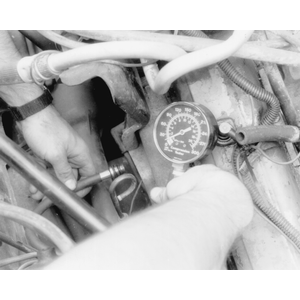A noticeable lack of engine power, excessive oil consumption and/or poor fuel mileage measured over an extended period are all indicators of internal engine wear. Worn piston rings, scored or worn cylinder bores, blown head gaskets, sticking or burnt valves, and worn valve seats are all possible causes. A check of each cylinder’s compression will help locate the problem.
| Screw-in type compression gauge

|
- Ensure that the engine is filled with oil to the proper level and with the appropriate type (viscosity).
- Ensure the battery is fully charged.
- Warm-up the engine to normal operating temperature then shut off the engine.
- Disable the fuel and ignition systems.
- Label and disconnect all of the spark plug wires from the plugs.
- Thoroughly clean the cylinder head area around the spark plug ports, and then remove the spark plugs.
- Open the throttle plate fully to the wide-open-throttle position.
- Block the accelerator linkage open, or have an assistant fully depress the accelerator pedal.
- Install a screw-in type compression gauge into the No. 1 spark plug hole until the fitting is snug.
- Connect a remote starting switch to the starting circuit.
- With the ignition switch in the OFF position, use the remote starting switch to crank the engine through at least five compression strokes (approximately 5 seconds of cranking) and record the highest reading on the gauge.
- Repeat the test on each cylinder, cranking the engine approximately the same number of compression strokes and/or time as the first.
- Compare the highest readings from each cylinder to that of the others.
- The indicated compression pressures are considered within specifications if the lowest reading cylinder is within 75 percent of the pressure recorded for the highest reading cylinder. For example, if your highest reading cylinder pressure was 150 psi (1034 kPa), then 75 percent of that would be 113 psi (779 kPa). So the lowest reading cylinder should be no less than 113 psi (779 kPa).
- If a cylinder exhibits an unusually low compression reading, pour a tablespoon of clean engine oil into the cylinder through the spark plug hole and repeat the compression test.
- If the compression rises after adding oil, it means that the cylinder’s piston rings and/or cylinder bore are damaged or worn.
- If the pressure remains low, the valves may not be seating properly (a valve job is needed), or the head gasket may be blown near that cylinder.
Oil and coolant in the combustion chamber, combined with blue or constant white smoke emitted from the tailpipe, are symptoms of a blown head gasket. There may be evidence of water droplets on the engine dipstick and/or oil droplets in the cooling system if a head gasket is blown. The oil will become the consistency of chocolate milk if water is present, and the coolant will appear muddy if oil is present.
Checking cylinder compression on diesel engines is basically the same procedure as on gasoline engines except for the following:
- A special compression gauge adapter suitable for diesel engines must be used because these engines have much greater compression pressures.
- Remove the injector tubes and remove the injectors from each cylinder.
NOTE: Remove and discard the injector sealing washers.
- When fitting the compression gauge adapter to the cylinder head, make sure the gauge pressure relief is closed.
- When reinstalling the injector assemblies, install new washers underneath each injector.

